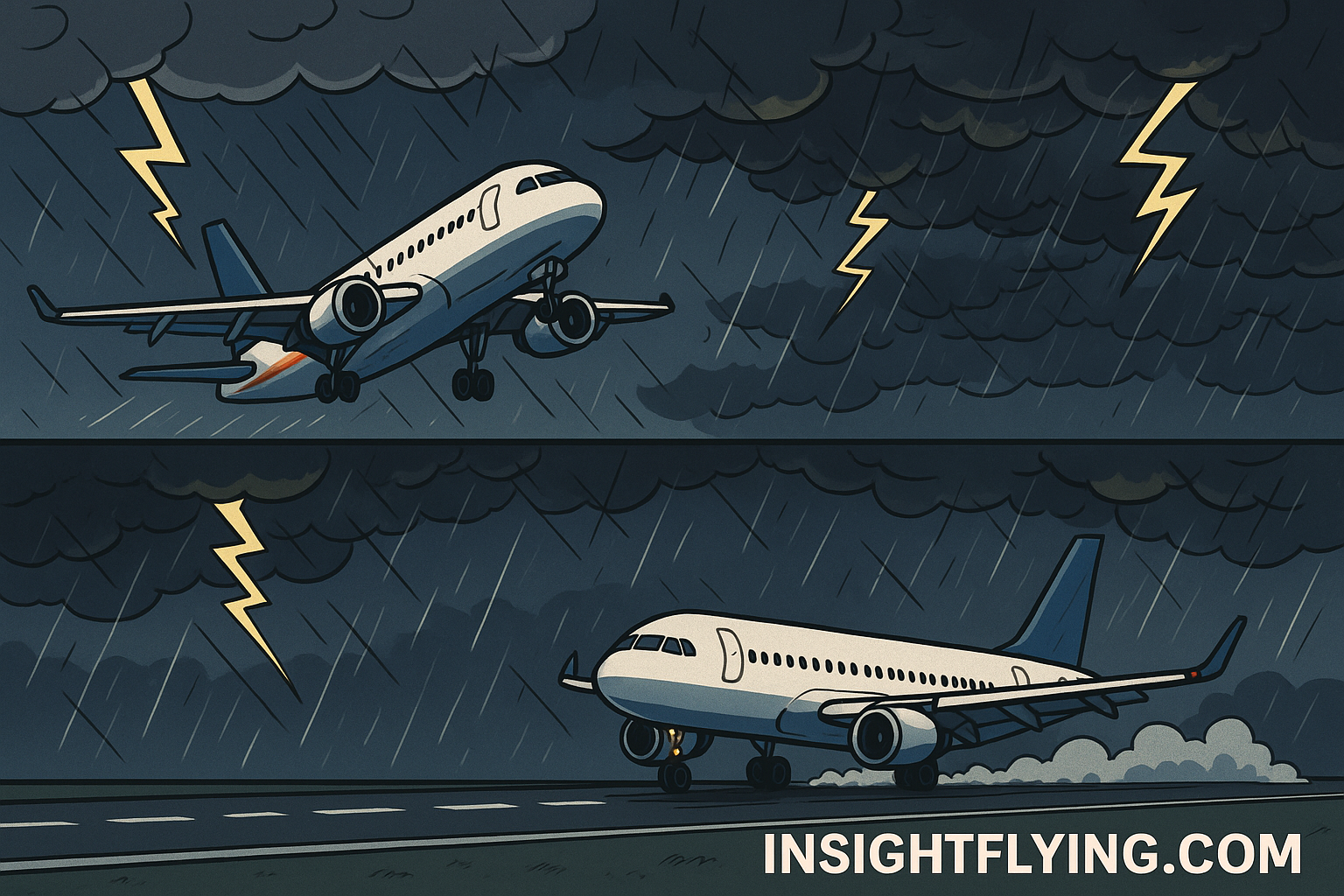ความเสี่ยงในการบินขึ้น: ทำไม “ไปต่อหรือหยุด” จึงเป็นการตัดสินใจที่สำคัญที่สุด
Most people think landing is the riskiest phase of flight. From a pilot’s perspective, landing may indeed be technically more challenging. But statistically, takeoff is actually riskier. Why? Because when problems occur during takeoff, the situation can escalate into a critical emergency in just seconds.
หลายคนเชื่อว่าการลงจอดคือช่วงที่อันตรายที่สุดของการบิน สำหรับนักบินแล้ว การลงจอดอาจจะซับซ้อนและต้องใช้ทักษะสูง แต่ตามสถิติแล้ว การบินขึ้นกลับมีความเสี่ยงมากกว่า เพราะถ้ามีปัญหาเกิดขึ้นในช่วงนี้ สถานการณ์สามารถพัฒนาไปสู่เหตุฉุกเฉินที่ร้ายแรงได้ภายในไม่กี่วินาที
Why Takeoff Carries Higher Risk
ทำไมการบินขึ้นถึงมีความเสี่ยงมากกว่า
- Maximum Weight
At takeoff, the aircraft is at its heaviest, carrying full fuel for the journey.
Example: A Boeing 747 departing Bangkok for London weighs around 380 tons at takeoff but only 240–250 tons upon arrival. น้ำหนักสูงสุด
ตอนบินขึ้น เครื่องบินจะหนักที่สุดเพราะบรรทุกเชื้อเพลิงเต็มถัง
ตัวอย่าง: Boeing 747 บินจากกรุงเทพไปลอนดอน น้ำหนักตอนบินขึ้นประมาณ 380 ตัน แต่เมื่อลงจอดที่ลอนดอนเหลือเพียง 240–250 ตัน - Engines at Full Power
Engines are pushed to maximum thrust during takeoff, increasing stress and the chance of failure. เครื่องยนต์ทำงานเต็มกำลัง
เครื่องยนต์ใช้กำลังเกือบสูงสุดขณะวิ่งขึ้น ทำให้มีโอกาสขัดข้องมากกว่าช่วงการบินอื่น - High Speed, High Impact
Takeoff speeds often reach 170–180 knots (270–290 km/h) in just over one minute. Any failure at this point has severe consequences. ความเร็วสูง ผลกระทบรุนแรง
ความเร็วขณะวิ่งขึ้นถึง 170–180 นอต (270–290 กม./ชม.) ภายในเวลาประมาณ 1 นาที หากมีปัญหาเกิดขึ้น ผลกระทบจะรุนแรงมาก - Very Limited Time to Decide
Pilots have about 3 seconds—two to analyze the problem and one to act. เวลาจำกัดมากในการตัดสินใจ
นักบินมีเวลาเพียงประมาณ 3 วินาที—สองวิเคราะห์ปัญหา และอีกหนึ่งเพื่อตัดสินใจ
Abort or Continue? The Role of V1
จะหยุดหรือไปต่อ? ความสำคัญของความเร็ว V1
Pilots rely on a critical speed called V1 (Decision Speed):
- Below V1: Safer to reject takeoff. The runway is long enough to stop.
- Above V1: Must continue. Stopping would risk overrunning the runway.
นักบินใช้ความเร็วที่เรียกว่า V1 (Decision Speed) เป็นเกณฑ์ในการตัดสินใจ:
- ต่ำกว่า V1: ปลอดภัยกว่าที่จะหยุด เพราะความยาวทางวิ่งยังเพียงพอ
- สูงกว่า V1: ต้องไปต่อ ถ้าหยุดจะเสี่ยงเลยทางวิ่ง
👉 This split-second choice is summed up as: “Go or Stop?”
👉 การตัดสินใจเสี้ยววินาทีนี้ สรุปได้ว่า: “จะไปต่อหรือหยุด?”
The Reality of Abort Takeoff
ความจริงของการยกเลิกการบินขึ้น
If a pilot aborts takeoff below V1:
- Autobrake engages at maximum force.
- Deceleration is extreme, comparable to slamming the brakes in a car—but at nearly 300 km/h.
- Passengers may feel a violent jolt.
หากนักบินตัดสินใจยกเลิกการบินขึ้นก่อนถึง V1:
- ระบบเบรกอัตโนมัติ (Autobrake) จะทำงานเต็มกำลัง
- อัตราการชะลอความเร็วรุนแรงมาก คล้ายกับการเหยียบเบรกเต็มแรงในรถยนต์ แต่ที่ความเร็วเกือบ 300 กม./ชม.
- ผู้โดยสารอาจรู้สึกแรงกระชากอย่างชัดเจน
This is why holding infants properly and sitting correctly during takeoff is so critical.
นี่คือเหตุผลที่การนั่งท่าปลอดภัยและอุ้มทารกอย่างมั่นคงในช่วงบินขึ้นจึงสำคัญมาก
Gross Weight Chart (GWC): The Hidden Calculation
ตารางน้ำหนักเครื่องบิน (GWC): การคำนวณที่ซ่อนอยู่
Before every flight, pilots consult Gross Weight Charts (GWC), which determine:
- V1, Vr, and V2 speeds based on aircraft weight, runway length, elevation, and temperature.
- Example: A 747 might take off at 320 tons on a 2,500 m runway, but can depart at maximum weight of 394 tons on a 4,000 m runway.
ก่อนบินทุกครั้ง นักบินจะตรวจสอบ Gross Weight Chart (GWC) ซึ่งจะกำหนด:
- ค่า V1, Vr, และ V2 ตามน้ำหนักเครื่องบิน ความยาวทางวิ่ง ระดับความสูง และอุณหภูมิ
- ตัวอย่าง: 747 สามารถบินขึ้นที่ 320 ตัน บนทางวิ่ง 2,500 ม. แต่ถ้าเป็นทางวิ่ง 4,000 ม. สามารถบินขึ้นได้เต็มน้ำหนักสูงสุด 394 ตัน
These calculations are life-critical: they decide whether the aircraft can take off or stop safely.
การคำนวณเหล่านี้เป็นเรื่องของความเป็นความตาย เพราะเป็นตัวกำหนดว่าเครื่องบินจะบินขึ้นหรือหยุดได้อย่างปลอดภัยหรือไม่
Passenger Safety Tip
ข้อแนะนำสำหรับผู้โดยสาร
When the cabin crew announces: “Cabin Crew, Prepare for Takeoff”
- Sit upright with seatbelt fastened
- Avoid crossing legs
- Secure infants with proper support
เมื่อได้ยินประกาศว่า “ลูกเรือเตรียมพร้อมสำหรับการบินขึ้น”
- นั่งตัวตรง คาดเข็มขัดนิรภัยให้เรียบร้อย
- อย่าไขว่ห้าง
- อุ้มเด็กทารกอย่างมั่นคงโดยพยุงศีรษะและคอ
Because in aviation, safety always comes before comfort.
เพราะในการบิน ความปลอดภัยมาก่อนความสบายเสมอ
